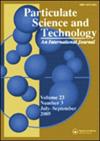Influence of different inlet modes on hot carrier gas flow in magnesium nitrate pyrolysis furnace
IF 1.5
4区 工程技术
Q3 ENGINEERING, CHEMICAL
引用次数: 0
Abstract
AbstractSpray pyrolysis of magnesium nitrate is a way to prepare magnesium oxide solid particles. The gas–solid flow process after the generation of solid particles inside the pyrolysis furnace was studied in this article. Six different inlet modes of hot-carrier gas were designed, and the hot-carrier gas enters the pyrolysis furnace at the same flow rate through the six different inlet modes. The influence of varying inlet methods on the actual running distance of gas flow and the particle sedimentation rate was deeply studied in this article. The longer the distance the hot-carrier gas runs in the pyrolysis furnace, the more conducive it is to full contact with the material. The higher the particle settling rate, the more magnesium oxide particles are collected in the pyrolysis furnace. ANSYS Fluent was used for numerical simulation in this study. The results indicate that when using a tangential inlet, the actual running distance of the hot-carrier gas in the pyrolysis furnace is longer than that of the normal inlet. The actual running distance of the thermal carrier gas at the three tangential inlets is 46.5 m, and that at a single normal inlet is 24.7 m. The former is 88% more than the latter. The sedimentation rate of solid particles at three tangential inlets is 32.24%, and that at a single normal inlet is 12.06%. The former is 167% higher than the latter. The three tangential inlet mode is the best way to increase the actual running distance of the hot-carrier gas and improve the solid particle settling rate in the pyrolysis furnace. The pyrolysis furnace with multiple tangential inlets has two advantages. On the one hand, increasing the running distance of the hot-carrier gas in the furnace is conducive, thereby making the contact between the hot-carrier gas and the material more sufficient. On the other hand, it can increase the capture rate of product particles, improve the product yield, and reduce the dust content of pyrolysis tail gas.Keywords: Magnesium nitratenumerical simulationpyrolysis furnacespray pyrolysis Disclosure statementNo potential conflict of interest was reported by the author(s).Additional informationFundingThe authors would like to acknowledge the financial support for this was provided by the National Key R&D Program of China’s ‘Technologies and Integrated Application of Magnesite Waste Utilization for High-Valued Chemicals and Materials’ (2020YFC1909303).不同入口方式对硝酸镁热解炉热载气流动的影响
摘要硝酸镁喷雾热解是制备氧化镁固体颗粒的一种方法。本文研究了热解炉内固体颗粒生成后的气固流动过程。设计了6种不同的热载气入口方式,热载气通过6种不同的入口方式以相同的流速进入热解炉。本文深入研究了不同进气方式对气流实际运行距离和颗粒沉降速率的影响。热载气在热解炉内运行的距离越长,越有利于与物料充分接触。颗粒沉降速率越高,热解炉中收集到的氧化镁颗粒越多。本研究采用ANSYS Fluent进行数值模拟。结果表明:采用切向进口时,热载气在热解炉内的实际运行距离比正常进口时要长。热载气在三个切向入口的实际运行距离为46.5 m,在单个法向入口的实际运行距离为24.7 m。前者比后者高出88%。固体颗粒在三个切向入口的沉降率为32.24%,在单个正常入口的沉降率为12.06%。前者比后者高出167%。三切向进料方式是增加热载气实际运行距离和提高热解炉固体颗粒沉降率的最佳方式。采用多切向入口的热解炉有两个优点。一方面,增加热载气在炉内的运行距离是有利的,从而使热载气与物料的接触更加充分。另一方面可以提高产品颗粒的捕获率,提高产品收率,降低热解尾气的含尘量。关键词:硝酸镁数值模拟热解炉喷雾热解披露声明作者未报告潜在利益冲突。作者感谢国家重点研发项目“高价值化学品和材料菱镁矿废资源化利用技术及综合应用”(2020YFC1909303)的资助。
本文章由计算机程序翻译,如有差异,请以英文原文为准。
求助全文
约1分钟内获得全文
求助全文
来源期刊

Particulate Science and Technology
工程技术-工程:化工
CiteScore
4.40
自引率
4.00%
发文量
86
审稿时长
12 months
期刊介绍:
Particulate Science and Technology, an interdisciplinary journal, publishes papers on both fundamental and applied science and technology related to particles and particle systems in size scales from nanometers to millimeters. The journal''s primary focus is to report emerging technologies and advances in different fields of engineering, energy, biomaterials, and pharmaceutical science involving particles, and to bring institutional researchers closer to professionals in industries.
Particulate Science and Technology invites articles reporting original contributions and review papers, in particular critical reviews, that are relevant and timely to the emerging and growing fields of particle and powder technology.
 求助内容:
求助内容: 应助结果提醒方式:
应助结果提醒方式:


